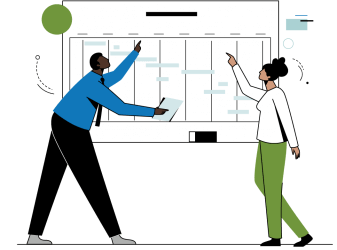
CEO Insights on Driving Digital Transformation
AVIA
Insights
AVIA

When it comes to driving impactful digital transformation, few things are more valuable than getting the on-the-ground perspective of colleagues and peers. Innovator Spotlight is a new series from AVIA that features interviews with the people who are on the front lines of this crucial work: leaders from our Member health systems and hospitals, who are tasked with putting digital transformation into practice and driving the industry forward.
For our inaugural Innovator Spotlight, we spoke with Andrea Werner, Senior Vice President, Population Health Strategy and Transformation at Bellin Health. Andrea shared her insights on the rapid pace of change in the healthcare industry, the challenges of delivering ROI and ensuring digital equity, and gave us a look at some of the initiatives Bellin Health is launching in the coming year.
(Note: As of Dec. 1, Andrea Werner will be the Chief Population Health Officer for Bellin-Gundersen Health System.)
Digital transformation at Bellin is a lever we can pull to help excel the overall transformation into a population health organization. Our work is prioritized based on our strategic objectives. Our major focus this year has been continuing our journey in creating a digital front door. It is a really important initiative for us, because it’s strategically connected to our patient experience work. It was a real “bet the farm” initiative and we’ve put a great deal of time and energy into it. One example is optimizing our chatbot—we’re now able to use it to better align primary care patients with us and as an effective and meaningful symptom checker. I would say our most notable work is focusing with intention on hyperpersonalized patient communication, respecting the uniqueness of all we serve. This includes a focus on language access. Your digital front door should not have an asterisk that says “only if you speak English”.
We’ve also put a lot of effort into our website, which plays a significant role in our digital front door, and in making it easier to schedule with us.
Lastly, we’re building out a consumer engagement center to empower us in delivering on our promise of really knowing our customers. We’ve made significant progress on discovery for the ideal contact center experience for our patients, and we now have our roadmap to start planning for the actual build.
Over the next 12 to 24 months, we need to continue making consistent progress on our digital front door. We are also focusing with intention on being able to design a framework for return on value. This is very different from a traditional ROI. At the same time, we need to start really thinking about a strategy for automation of processes. It’s something that’s very siloed right now in our organization, and we need to move towards having a holistic automation strategy and roadmap.
We are also very passionate about digital equity, and making sure everyone is able to access and benefit from technology. We have made progress in our ability to capture REAL and SOGI data and now we are using that data to identify disparities and start the heavy lifting of closing them.
The biggest one is culture change—number one, hands down. People naturally fear change, and it is normal to wonder what automation means to an individual’s job. It’s important for teams to understand that you can introduce technology in a way that lets them offload some tasks—I don’t want to say low value, because it’s all valuable—but the work that humans don’t need to do. That’s the challenge: helping our colleagues understand that the focus is on letting their staff work on more meaningful things.
Another major barrier is our relationship to EMRs. So many health systems have invested millions and millions of dollars in their EMRs, and many of us have been waking up every day for a long time now thinking about how to optimize that value. We need to have an “EMR optimization first” mindset, and we need to understand that an EMR wasn’t built to deliver everything we need or everything that our customers are asking for today. The EMR companies are trying to catch up, but they’re not fast enough. We need to have an “EMR and…” mindset, and not an “only the EMR” mindset.
I’m really watching for the things that help people live their healthiest lives. I think “Home is the site of care” is the wave of the future—there’s a lot going on in that space. Precision medicine is another area I’m watching closely. There’s some great products out there. People are looking at whether we can help people change their metabolism through precision medicine, and possibly reverse Type II diabetes. I’m also keeping a close eye on health and wellbeing technologies, and anything that is automation of process and directly impacts the workforce.
I’m also always looking for an easy analytics platform that will make it simple and obvious to know how to help people. When you think about managing populations, data is so important. That data must be turned into knowledge, which turns into action, and then you can get results. Comprehensive population health analytics are definitely on my radar.
We need to go as far upstream as we can in helping people be healthy and avoid disease—and maybe even put disease in remission—through behavior and lifestyle changes. That’s where greatest opportunities exist in truly being able to deliver the Triple Aim. People suffer in ways that can be avoided. They spend money when they get sick: either out of their own wallets, or in terms of our country, which drives up the cost of healthcare. Helping people avoid disease is the best way to address that. This cannot be done in the absence of considering social determinants of health and health equity.
When I think about opportunities for technology and innovation in the future, I think, “How can we get really creative to help people live their healthiest lives leveraging technology, way upstream?” Not just in terms of one life, but collectively, as populations—and in the places people live and work and play, and not just in a clinical space. We also need to be thinking about whether the technology we’re designing is equitable. We have to make sure we’re not leaving people behind. If you design with the mindset of “The last shall be first,” everyone benefits.
I think one of the most important things to call out in the space of population health is that there needs to be a well thought out long range plan and related metrics. Digital technology needs to be part of that greater vision, and it all needs to be connected. The biggest risk is getting distracted with the boom in health tech. Slow, steady, intentional, and focused on the endgame is the way to go.
Do you want to join a network of the most innovative health systems in America? Are you ready to put digital innovation into practice? Contact AVIA to find out how you can accelerate the speed and impact of digital at your health system.